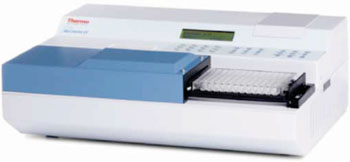Rapid Agglutination Latex Test Developed for Diarrheagenic Pathogens
By LabMedica International staff writers
Posted on 09 Oct 2014
Enteropathogenic and enterohemorrhagic Escherichia coli (EPEC/EHEC) are human intestinal pathogens responsible for diarrhea in both developing and industrialized countries.Posted on 09 Oct 2014
A rapid and simple assay for EPEC/EHEC detection has been developed using the EPEC/EHEC-secreted proteins EspA and EspB, which were chosen as target antigens since they are the major secreted proteins in both pathogens.
Bacteriologists at the Instituto Butantan (São Paulo, Brazil) analyzed 71 atypical EPEC (aEPEC), 31 typical EPEC (tEPEC), and 23 EHEC belonging to different serotypes characterized as locus of enterocyte effacement (LEE)-positive isolates. The secreted proteins EspA and EspB were detected using an enzyme linked immunosorbent assay and the absorbance was measured at 492 nm in a Multiskan EX ELISA reader (Thermo Scientific; Waltham, MA, USA).
For rapid agglutination latex test (RALT), bacterial isolates were grown on Dulbecco’s modified Eagle’s medium (DMEM)-agar and the tests were done using latex sensitized with anti-EspB monoclonal antibody (MAb). The RALT was performed on a slide glass using 20 µL of bacterial lysate and 20 µL of latex beads coupled to anti-EspB (MAb), and checking for agglutination after five minutes of gentle mixing. The EspB secreted protein was defined as a biomarker and its corresponding monoclonal antibody as the tool for EPEC/EHEC diagnosis; the production of EspB was better in DMEM medium.
The indirect ELISA using anti-EspB MAb showed 90.4% sensitivity and 96.4%, specificity, indicating its possible use in routine diagnostic laboratories. However, this methodology requires specific laboratory instrumentation, making it difficult to be performed in low-income country settings. The RALT assay can be considered an alternative assay for diarrhea diagnosis in low-income countries since it achieved 97% sensitivity, 98% specificity and 97% efficiency. RALT assay has the sensitivity and specificity required for high-impact diagnosis of neglected diseases in the developing world.
The authors concluded that serotyping-based diagnosis is the only methodology available in limited-resources settings, employing either commercial or in-house antisera. The standardized RALT for detection of EPEC and EHEC will have a remarkable impact in the diagnosis of these pathotypes, as the established agglutination latex test is a simple, rapid and easy to perform test, which can be employed in less equipped laboratories in low-income countries. The study was published on September 25, 2014, in the Public Library of Science Neglected Tropical Diseases.
Related Links:
Instituto Butantan
Thermo Scientific















